Posted by McElroy Metal ● Jul 27, 2022 8:00 AM
What is the Best Underlayment for a Metal Roof?
Underlayment products provide a barrier of weather protection for a building's interior both during and after construction.
During construction, an underlayment protects the structure from water infiltration before the installation of the final roof covering.
After construction, the underlayment helps shed water that may find its way into the roofing system.
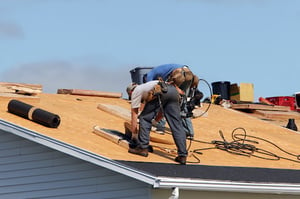
To understand which underlayment presents the best option, let’s start with an explanation of the main three types:
- Felt paper products are mechanically attached.
- Synthetic underlayments that are mechanically attached.
- Synthetic underlayments that are attached with the peel and stick technology.
Each underlayment option offers pros and cons, especially when working with metal roofing.
Felt Paper Underlayments
Felt paper is made from wood or fiberglass and coated with a product like asphalt to provide water repellency. This product family is often referred to as roofing felt or tar paper.
Historically, asphalt-saturated felt underlayments were the go-to roof underlayment choice. However, over the last decade, the market share for these product types has been dramatically reduced.
Advantages
- Most economical underlayment
Disadvantages
- Small Roll Size: Felt paper is commonly available in 2 square rolls or enough material to cover roughly a 10’ x 20’ area. Other underlayment product types, synthetic, for example, can cover up to 10 squares (or five times more) in a single roll.
- Increased Weight: This product type weighs considerably more than other underlayment options. For example, a 2 square roll of #30 felt weighs around 43 pounds, and a 10 square foot roll of synthetic weighs roughly the same.
- Increased Labor: The small roll size and weight contribute to increased labor and, ultimately, higher installation costs.
- Increased Time to Install: Installation can be challenging as asphalt-based products tend to buckle and wrinkle during installation.
- Recyclability: As the name implies, these products contain asphalt. Consequently, their use raises environmental issues. Additionally, recycling is not commonly available.
- Permeability: Asphalt-based products have a higher permeability rating than other underlayment materials. A higher permeability rating means they can absorb water and lead to roof deck rot when not allowed to dry completely before the installation of the final roofing material or when compromised roofing systems will enable the intrusion of water.
- Color: The black color of asphalt-based products means they absorb more sun and consequently introduce more heat than synthetic underlayments, which tend to be gray.
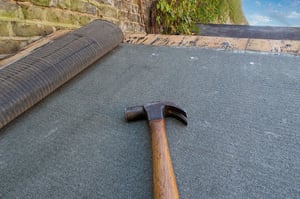
- Durability - UV Resistance: Ultraviolet rays cause felt paper products to break down very quickly. The final roofing product should be installed as soon as possible after the underlayment. While felt manufacturers propose a 30-60 exposure window, one to two weeks is the more typical real-world expectation.
- Long-Term Durability: Felt paper products fail to match the long-term durability of metal roofing. Metal roofing boasts a 60-year life expectancy, while asphalt-based underlayments offer a 15-20 year life expectancy. It simply doesn’t make sense to put a longer-life product on top of a product that fails earlier.
- Availability: Asphalt-based products offer little wiggle room for schedule delays, changes, and manufacturing issues, especially considering current supply chain and labor issues.
General Recommendation
The attraction of the low price point quickly fades with the addition of product performance to the purchase decision.
Consequently, we do not recommend using asphalt-based roofing products under metal roof panels.
Synthetic Underlayments-Mechanically Attached
Synthetic underlayments use laminated polypropylene or polyethylene plastic technology. The underlayment is then mechanically attached to the roof.
With a 20-year history, synthetic underlayments offer numerous striking advantages over traditional tar or asphalt-based felt paper.
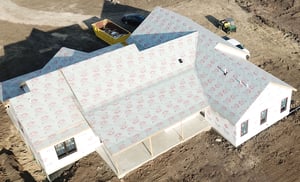 Advantages
Advantages
- Strength: Synthetic underlayments are 10-15% stronger than felt underlayments. The product strength leads to significantly reduced issues with blow-off and tearing.
- Installation: 10 square rolls (compared to the two square rolls of felt paper). Single roll covers 5x more than asphalt products and weighs far less. Larger rolls lead to faster installation and fewer trips to get more product. Both favorably impact installed cost.
- Installation: The product has fewer buckles and wrinkling than asphalt-based products.
- Cold Weather Installation: It remains flexible in cold weather, making it easier to maneuver and consequently more contractor-friendly.
- Longevity: Synthetic underlayment can be exposed to ultraviolet rays for much longer without impacting its effectiveness. It’s not uncommon for synthetic products to be exposed for six to nine months and perform as expected.
- Improved Walkability: Synthetic products offer greatly improved walkability and improved installer safety.
- Color: Most synthetic underlayments are gray. Consequently, they absorb far less heat than asphalt-based products, which are black.
Disadvantages
- In some cases, product installation uses capped nails. These caps can occasionally telegraph through the roof when using a flat panel condition (without striations). Consequently, it’s crucial to complete a small test area first. If cap telegraphing is an issue, check with the manufacturer for their recommendation.
- Holes created when installing the final roofing material (metal in this case) remain unsealed.
General Recommendation
While this category of underlayments provides cost-effective coverage in the field of the roof, it may come up short in critical conditions such as eaves, valleys, ridges, hips, and rakes.
Consequently, it’s generally combined with the use of peel and stick synthetic products.
Synthetic Underlayments attached with Peel & Stick Technology
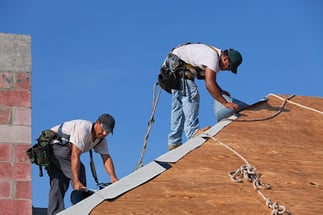
Synthetic peel and stick synthetic underlayment is typically comprised of a three-layer construction method:
- Top Layer – Synthetic Underlayment
- Middle Layer - Modified Bitumen
- Bottom Layer - Adhesive
The modified bitumen middle layer allows this family of products to self-seal around small penetrations like those created by fasteners while installing the primary roofing material. Many folks refer to products in this category by the name Ice and Water ShieldⓇ, marketed by GCP Applied Technologies.
Advantages
The advantages previously identified in the mechanically attached synthetic underlayment section also apply to synthetic peel and stick products:
- Product Strength
- Installation Ease/Lightweight
- Longevity
- Improved Walkability
- Color
Additionally, peel and stick products provide the additional benefits highlighted below:
- Sealability around fasteners used to attach the primary roofing material.
- Rarely experiences blow-off failures.
- Greater product thickness (typically 40-48 mil) provides greater protection. For comparison, mechanically attached synthetic underlayments can fall in the 6 mil range.
Disadvantages
- Cost: Peel and stick products represent the most expensive underlayment option.
- Hi-Temp Required: Using hi-temp products when pairing with metal roofing is essential. While low-temperature products can be less expensive, they also tend to fail (or melt) when used with metal roofing.
General Recommendation
While they offer the best performance, due to cost, peel and stick underlayments are commonly used only in critical areas such as valleys, ridges, hips, eaves, chimneys, and other penetrations.
However, they can be used to cover 100% of the roofing surface when desired.
A combination of mechanical and peel and stick attachment methods is the most common to optimize performance and minimize cost.
Learn More
Want to learn more about metal roof underlayment and how to install it? Check out this article.
About McElroy Metal
Since 1963, McElroy Metal has served the construction industry with quality products and excellent customer service. The employee-owned components manufacturer is headquartered in Bossier City, La., and has 14 manufacturing facilities across the United States. Quality, service and performance have been the cornerstone of McElroy Metal’s business philosophy and have contributed to the success of the company through the years. As a preferred service provider, these values will continue to be at the forefront of McElroy Metal’s model along with a strong focus on the customer.
Topics: Metal Roofing, Substructural Components, FAQ, Installation, Architect Resources
Comments on this article:
Scroll down to the bottom to submit a comment and join the conversation. Need help or have a question? Please contact us.

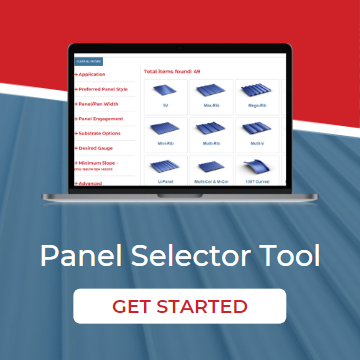
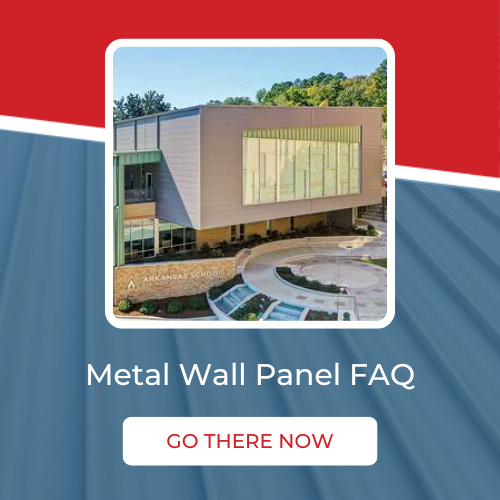








%20(002).png)